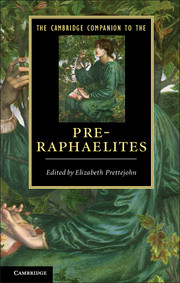Book contents
- Frontmatter
- Introduction
- PART ONE PRE-RAPHAELITISM
- PART TWO PRE-RAPHAELITES
- 6 The poetry of Dante Gabriel Rossetti (1828–1882)
- 7 The painting of Dante Gabriel Rossetti
- 8 William Holman Hunt (1827–1910)
- 9 John Everett Millais (1829–1896)
- 10 Ford Madox Brown (1821–1893)
- 11 Christina Rossetti (1830–1894)
- 12 Elizabeth Eleanor Siddall (1829–1862)
- 13 The writings of William Morris (1834–1896)
- 14 The designs of William Morris
- 15 Edward Burne-Jones (1833–1898)
- 16 Algernon Charles Swinburne (1837–1909)
- 17 William Michael Rossetti (1829–1919)
- 18 Envoi
- Appendix 1 The contents of The Germ
- Appendix 2 The Pre-Raphaelite ‘list of Immortals’
- Guide to further reading and looking
- Cambridge Companions to …
- Index
18 - Envoi
from PART TWO - PRE-RAPHAELITES
Published online by Cambridge University Press: 28 September 2012
- Frontmatter
- Introduction
- PART ONE PRE-RAPHAELITISM
- PART TWO PRE-RAPHAELITES
- 6 The poetry of Dante Gabriel Rossetti (1828–1882)
- 7 The painting of Dante Gabriel Rossetti
- 8 William Holman Hunt (1827–1910)
- 9 John Everett Millais (1829–1896)
- 10 Ford Madox Brown (1821–1893)
- 11 Christina Rossetti (1830–1894)
- 12 Elizabeth Eleanor Siddall (1829–1862)
- 13 The writings of William Morris (1834–1896)
- 14 The designs of William Morris
- 15 Edward Burne-Jones (1833–1898)
- 16 Algernon Charles Swinburne (1837–1909)
- 17 William Michael Rossetti (1829–1919)
- 18 Envoi
- Appendix 1 The contents of The Germ
- Appendix 2 The Pre-Raphaelite ‘list of Immortals’
- Guide to further reading and looking
- Cambridge Companions to …
- Index
Summary
But the really odd thing about the Pre-Raphaelite literature, vast though it is, is how many of the obvious and essential books remain to be written.
Editorial, The Burlington Magazine, February 1973Odder still: four decades later, when the Pre-Raphaelite literature has grown far vaster, the statement remains true. Perhaps, though, that marks not a deficiency in Pre-Raphaelite scholarship, but rather an unquenchable vitality in Pre-Raphaelite art and literature, a continual capacity for reinvention that keeps calling for new ‘essential books’. Admittedly, there is much that is routine, or repetitive, in Pre-Raphaelite studies. How often, for example, have we heard the story of the initial shocked response to the PRB, followed by its rise to fame, and then its dissolution as the Brothers went their separate ways (to D. G. Rossetti in 1853, this already read as a parallel to the story of Arthur and his Knights of the Round Table)? Or the corresponding story, with its inverted curve, of the precipitous decline in the Pre-Raphaelites’ reputation at the end of the nineteenth century, followed by a revival in more recent years? It is as though the Pre-Raphaelite defiance of convention still needs to be tamed, through the compulsive repetition of these familiar narrative patterns.
Much of the energy in the most recent phase of the much-vaunted revival has been devoted to exploding the first of these conventional narratives: to demystifying the story of the PRB’s early days as it was constructed in William Holman Hunt’s autobiography, to re-evaluating and recontextualizing the early criticism of the group, or to questioning the story of inevitable decline that has dogged accounts of the later careers of so many of the Pre-Raphaelites.
- Type
- Chapter
- Information
- The Cambridge Companion to the Pre-Raphaelites , pp. 265 - 272Publisher: Cambridge University PressPrint publication year: 2012
- 1
- Cited by

